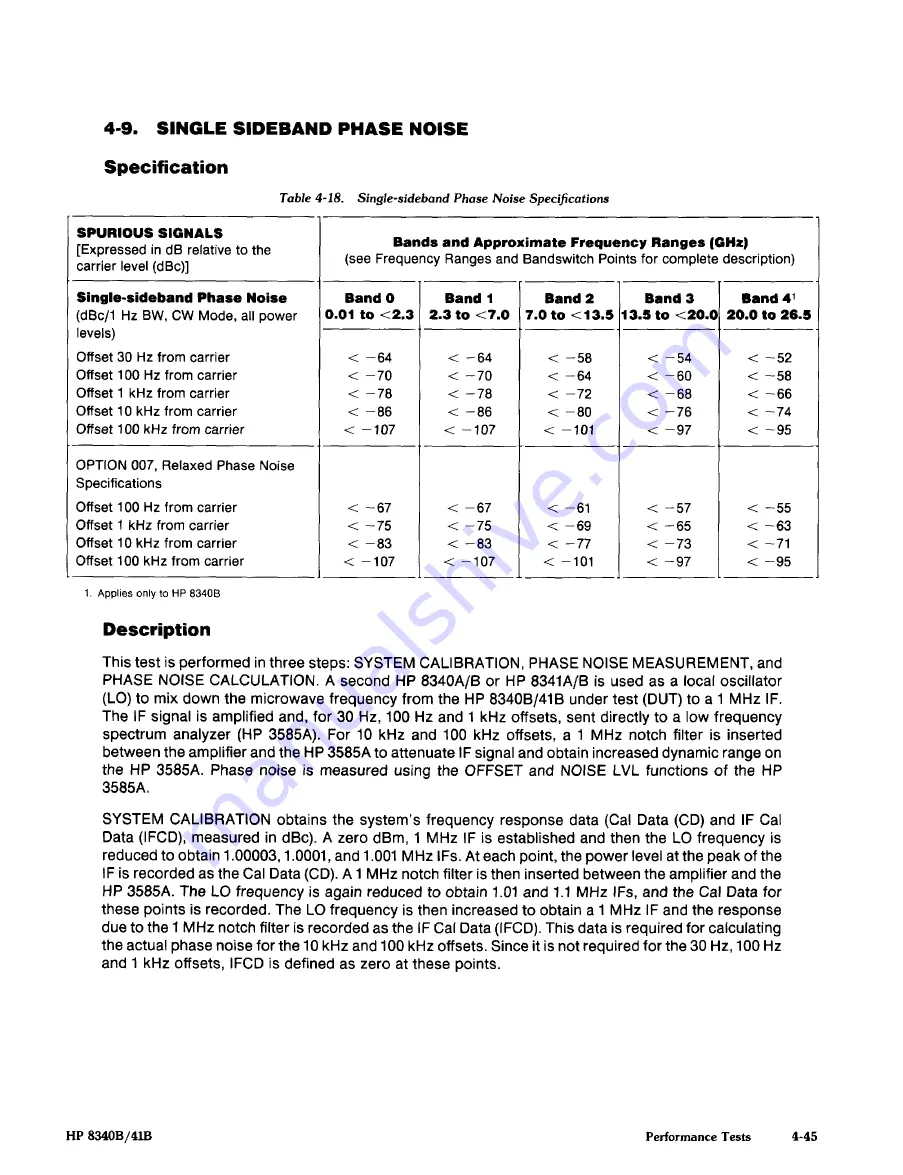
4-9.
SINGLE SIDEBAND PHASE NOISE
Specification
Table 4-18.
Single-sideband Phase Noise Specifications
SPURIOUS SIGNALS
[Expressed
in dB relative to the
carrier level (dBc)]
Bands and Approximate Frequency Ranges (0Hz)
(see Frequency Ranges and Bandswitch Points for complete description)
Single-sideband Phase Noise
(dBc/1 Hz BW, CW Mode, all power
levels)
Offset 30 Hz from carrier
Offset 100 Hz from carrier
Offset 1 kHz from carrier
Offset 10 kHz from carrier
Offset 100 kHz from carrier
Band 0
0.01 to <2.3
Band I
2.3 to <7.0
Band 2
7.0 to <13.5
Band 3
13.5 to <20.0
Band 41
20.0 to 26.5
< —64
< —70
< —78
< —86
< —107
< —64
< —70
< —78
< —86
< —107
< —58
< —64
< —72
< —80
< —101
< —54
< —60
< —68
< —76
< —97
< —52
< —58
< —66
< —74
< —95
OPTION 007, Relaxed Phase Noise
Specifications
Offset 100 Hz from carrier
Offset 1 kHz from carrier
Offset 10 kHz from carrier
Offset 100 kHz from carrier
< —67
< —75
< —83
< —107
< —67
< —75
< —83
< —107
< —61
< —69
< —77
< —101
< —57
< —65
< —73
< —97
< —55
< —63
< —71
< —95
1 Applies only to HP 8340B
Description
This test is performed in three steps: SYSTEM CALIBRATION PHASE NOISE MEASUREMENT, and
PHASE NOISE CALCULATION. A second HP 8340A/B or HP 8341A/B is used as a local oscillator
(LO) to mix down the microwave frequency from the HP 8340B/41B under test (DUT) to a 1 MHz IF.
The IF signal is amplified and, for 30 Hz, 100 Hz and 1 kHz offsets, sent directly to a low frequency
spectrum analyzer (HP 3585A). For 10 kHz and 100 kHz offsets, a 1 MHz notch filter is inserted
between the amplifier and the HP 3585A to attenuate IF signal and obtain increased dynamic range on
the HP 3585A. Phase noise is measured using the OFFSET and NOISE LVL functions of the HP
3585A.
SYSTEM CALIBRATION obtains the system’s frequency response data (Cal Data (CD) and IF Cal
Data (IFCD), measured in dBc). A zero dBm, 1 MHz IF is established and then the LO frequency is
reduced to obtain 1.00003,1.0001, and 1.001 MHz IFs. At each point, the power level at the peak of the
IF is recorded as the Cal Data (CD). A 1 MHz notch filter is then inserted between the amplifier and the
HP 3585A. The LO frequency is again reduced to obtain 1.01 and 1.1 MHz IFs, and the Cal Data for
these points is recorded. The LO frequency is then increased to obtain a 1 MHz IF and the response
due to the 1 MHz notch filter is recorded as the IF Cal Data (IFCD). This data is required for calculating
the actual phase noise for the 10 kHz and 100 kHz offsets. Since it is not required for the 30 Hz, 100 Hz
and 1 kHz offsets IFOD is defined as zero at these points.
HP 8340B/41B
Performance Tests
4-45
















































